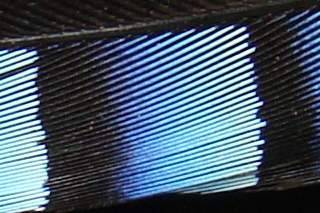Scattering
The html formatting and custom instructions have been disabled on this server. The same file with adapted formatting can be found here: https://farbeinf.de/static_html/scattering.html.The Colours of the Sky
Contact
Deutsche Version
ScatteringThe html formatting and custom instructions have been disabled on this server. The same file with adapted formatting can be found here: https://farbeinf.de/static_html/scattering.html.The Colours of the Sky |
| Dietrich Zawischa Contact Deutsche Version |
|
| In the air, part of the sunlight is scattered. The small particles (molecules, tiny water droplets and dust particles) scatter photons the more, the shorter their wavelength is. Therefore, in the scattered light, the short wavelengths predominate, the sky appears blue, while direct sunlight is somewhat yellowish, or even reddish when the sun is very low. Goethe believed this to be the basic phenomenon to generate colours (“Urphänomen”). |
|
| Due to the scattering of light the wood in the background is seen like behind a bluish veil (“aerial perspektive”). |
|
|
The colours of sunrise and sunset sometimes even show themselves on the moon. When during a lunar eclipse the earth shades the moon, some light is scattered into the shadow region by the earth's atmosphere. This light is reddish, as shorter wavelength light is largely scattered to other directions. As viewed from the moon, the earth's atmosphere would be seen as a shining border, red at the inner side if there are no clouds, and becoming pale and bluish outwards.
Partial lunar eclipse on August 16, 2008, photograph taken at 23:15 CEST |
 | computed colour of the sky |
|
|
Next we consider a small droplet which consists of N molecules of water and is assumed to be very small compared to the wavelengths of visible light. To simplify things, we assume that each of the molecules feels the field of the incident wave. In this crude approximation, the whole droplet behaves like a single molecule with an N-times larger polarizability, and the scattered wave has N2- times the intensity than that of a single molecule. As long as the droplet is small compared to the wavelengths, the short waves are scattered more than the longer ones.
Larger dropletsWith increasing droplet size the situation changes: the scattered waves coming from different parts of the drop interfere and partially extinguish each other. For large drops, the scattered waves coming from inside cancel each other, and what remains is interpreted as reflected and refracted waves. In this case (we speak of Mie scattering) the spectral composition of the scattered light depends on the scattering angle. In dense clouds, this dependence is averaged out by varying drop sizes and multiple scattering and the clouds appear white or grey. Thus, if the scattering particles are larger than the wavelengths of light, the light is scattered much more, but long and short waves are affected equally.In bulk (nonabsorbing) matter of constant density, the scattered waves cancel each other in all directions except the direction of propagation. Instead of scattering, the polarizability leads to a change of the wavelength which is accounted for by the introduction of a refractive index. |
Tyndall EffectIn clear water, light is scattered only to a negligible amount. Scattering occurs again, if small particles of different polarizability are suspended (Tyndall effect). Mastic (or some other kind of resin) dissolved in alcohol and added to water yields a turbid medium to observe this effect.The size of the suspended particles is decisive: if they are small compared to the wavelengths of light, colours are seen; if they are larger, the suspension appears just whitishly turbid. The images to the right show a suspension of spruce resin in water, lit by white light from a LED. At the very right: view through the liquid column on the lamp. |
| |
| Opal, an amorphous form of silica, is made up of submicroscopic silica spheres closely packed, the spaces between the spheres containing water or water-rich silica. Tyndall scattering at these inhomogeneities leads to bluish colour in reflected light, while in transmitted light it looks yellowish. In precious opal, macroscopic domains consist of spheres of uniform size, so that the inhomogeneities form regular lattices, as can be seen in the REM pictures supplied by the Mineral Spectroscopy Server of the
California Institute of Technology: opal_gem, opal-beads. Such regular lattices cause colourful reflections of light. Right: an opal from Ethiopia, length 22 mm | ||
|
Turbid, milky or opalescent glass is produced by adding fluorides (cryolite, Na3Al F6, sodium hexafluoroaluminate), calcium phosphate (bone ash) or tin dioxide to the smelting charge. By this, submicroscopically small crystals finely dispersed in the glass are obtained which scatter the light due to their different polarizability.
Cryolite glass (image to the right) looks bluish before a dark background and orange-yellow in transmitted light. |
| |
|
Scattering of light (Tyndall effect and, closely related, Rayleigh scattering) can thus be observed quite frequently. The iris of the human eye does not contain any blue pigment or dye. The turbid front layer, if it contains no or only little melanin, appears blue in front of the dark back layer due to the preferred scattering of light with short wavelengths. Blue eyes are probably the best known example of Tyndall scattering. |
|
Rayleigh scattering has been discussed for the case of rarefied gases, in that case the intensities of the scattered waves had to be summed up. At atmospheric pressure, a cube with edges 400 nm long (corresponding to the shortest visible wavelengths) contains 1.7·106 molecules. Are the conditions for independent scattering on the single molecules still valid or is this situation more similar to a uniform density where the scattering only leads to a refractive index? This question has been answered in the beginning of the 20th century by Einstein and Smoluchowski who found that scattering by the density fluctuations of a gas yields exactly the same as scattering on independent molecules.
Of course, the waves scattered by different particles interfere; but if the positions of the particles are randomly distributed, in the case of large numbers of scatterers, the interference terms are averaged to zero. Thus the intensity of the scattered light is just the sum of intensities from the individual scatterers.
In the animal kingdom, there are many examples of non-iridescent blue colour which is not produced by blue pigments. These are caused by layers of tissue with small-scale density variations (e.g. by suspended nanoparticles with high refractive index), on top of tissue coloured black by melanins. However, recent investigations have shown that the spectrum of the blue remitted light does not conform to the well known Rayleigh shape (inversely proportional to the fourth power of the wavelength), due to the fact that the positions of the scattering centres are not completely random; instead, there are short-range correlations (Prum et al., 1999a, 1999b, 2004a, 2004b). Thus, it is argued, the non-iridescent blue should rather be considered as a structural colour.

 |
We speak of Tyndall scattering in those cases where the scatterers are distributed with low density in a larger volume. To achieve noticeable scattering already in a thin layer, the particle density must be much higher. If the distribution were truely random, clots would form. Therefore, the organism tries to keep a certain minimum distance between the scattering particles. This does not lead to long-range order, but makes the distribution much more uniform. This is illustrated by the following stereo images.
Left pair: random distribution, right: statistical distribution with minimum distance between particles. Click to enlarge; cross-eyed viewing is recommended.
A small spherical domain with radius 4 μm is assumed to contain small Tyndall scatterers which are (a) randomly distributed or (b) must have a distance of at least 200 nm to their nearest neighbours. The coordinates are obtained from a random number generator. The scattered intensities show strong statistical fluctuations; to reduce these, average values over a larger number of similar systems are taken. Multiple scattering is ignored.
The graphs below show the intensities multiplied by the fourth power of the wavelength for the scattering angle of 120° (arbitrary units).
 Hyla arborea, European tree frog (photograph: User:Ineptus) | The green colour of amphibia and reptiles is produced in that manner. Different chromatophore cells are arranged in layers. Yellow chromatophores are the outermost, followed by guanophores (or iridophores) containing the suspension of guanine crystals on top of a dark layer of melanophores. (See: “Nature's palette” by Margareta Wallin.) |
|
Two parrots, photograph: RoFra, license CC BY 3.0 | Birds also make use of light scattering to produce green and blue colour, if these colours are not iridescent. How it is achieved is described in the article “Die Gefiederfarben der Vögel” (in German, sorry): The branches (barbs) of parrots' feathers which are fused to the feather's shaft consist of dark marrow surrounded by giant cells containing finely dispersed melanine particles. Due to their smallness and low concentration scattering outweighs absorption, and in front of the dark marrow they look blue. The outermost cell layer is transparent, colourless (blue feathers) or yellow, containing some carotenoid colourant (green feathers). The small barbules attached to the barbs are colourless or dark if they contain melanin. |
Ischnura elegans (van der Linden) Blue-tailed Damselfly, male | Some damselflies and dragonflies are decorated with non-iridescent, light blue colour. It is supposed that there the cells of the epidermis below the transparent cuticula contain a suspension of submicroscopic particles while the layer behind is coloured black by melanine (after Sternberg & Buchwald (1999): Die Libellen Baden-Württembergs, Band 1. (© Ulmer Verlag, Stuttgart), see “Körperbau der Libellen”). |
Guanophores in front of a dark background layer are seen blue like the blue sky as long as the suspended particles are small compared to the visible wavelengths and thus scatter the shorter waves much more than the longer ones. White light is remitted if the crystals are larger, like the droplets in clouds. (Iridescence is also possible if the crystals form a regular lattice or are platelike and oriented.)
Structural colours produced by regular nanostructures like stacks of transparent layers (beetles, hummingbirds, butterflies) or space-lattice like structures (peacocks' and pheasants' feathers, butterflies) exhibit the whole spectrum of bright colours, while the irregular distribution of small scatterers yields only sky-blue hues. This is kind of in-between of Tyndall scattering and structural colour.
Back to the index page “the origins of colour”
Continue with “diffraction and interference” (among otghers: iridescent clouds)
Continue with rainbows and other atmospheric phenomena
Legal Information Data Privacy